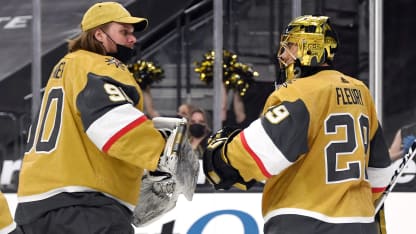What is the offseason plan for the Philadelphia Flyers? Expansion draft, free agency, cap situation and the failing defense are hot-button topics, not to mention goaltending. -- @theashcity
The Flyers have a potentially complicated offseason ahead, including the NHL Draft Lottery if they fail to qualify for the Stanley Cup Playoffs. Philadelphia is sixth in the eight-team MassMutual East Division, 11 points behind the fourth-place Boston Bruins. The top four teams make the postseason.
Though most of the Flyers roster is signed for next season, three players can become a restricted free agent after this season (forward Nolan Patrick, defenseman Travis Sanheim and goalie Carter Hart), and goalies Brian Elliott and Alex Lyon are pending unrestricted free agents. If the Flyers are going to venture into free agency, trades might be their only way to create roster space for a new player or players.
One of their greatest needs is a right-shot defenseman to play with Ivan Provorov after realizing how much they miss steady but retired Matt Niskanen. Philadelphia has allowed 173 goals this season, most in the NHL. It might be better to focus there.
Progress will require a step forward from Hart, a 22-year-old who is 9-11-5, 3.67 GAA, .877 save percentage and one shutout and missed six games with a sprained knee. The Flyers also have some difficult choices ahead of the expansion draft, and it's likely they will lose a good player. Who of defensemen Provorov, Sanheim, Philippe Myers or Shayne Gostisbehere would you leave unprotected? Or what price would you pay Seattle to not pick one? The same conundrum will exist among forwards. Could one of Patrick, Jakub Voracek, James van Riemsdyk or Travis Konecny be exposed?
The Flyers have a pick in each of the seven rounds of the 2021 NHL Draft, so those assets, if needed, can help reshape the roster.
Assuming the NHL goes back to the old divisions (Metropolitan, Atlantic, Central, Pacific) do you see the Ottawa Senators making the playoffs next season? -- @NaftaliClinton
It's a good bet the NHL returns to its normal divisions next season, placing the Senators back in the Atlantic. So the question becomes two parts: Will the Senators be good enough to qualify for the postseason, and how stiff is the competition?
There's no denying that the young talent being assembled in Ottawa is promising. We've seen progress from Thomas Chabot, Brady Tkachuk, Josh Norris, Drake Batherson,
Tim Stutzle
and Colin White, and the Senators have introduced prospects Shane Pinto and Jacob Bernard-Docker in the past couple of weeks. They're also 11-5-0 against the Montreal Canadiens and Calgary Flames, the fourth-place and fifth-place teams in the seven-team Scotia North Division, where the top four teams will qualify for the playoffs. Those are positives.
However, Ottawa was 2-12-1 to start the 56-game season, so all hope for the playoffs was lost and that changed many things. The development time for those young players was vital, but do you get a true read on a team when it plays the rest of its season in "garbage time"? The answer is impossible to know.
The other issue is goaltending. Is Matt Murray the long-term answer? He's 10-13-1 with a 3.38 goals-against average .893 save percentage and two shutouts in 27 games (25 starts) while missing time because injuries. I don't believe the Senators can make the playoffs in the Atlantic without high-caliber goaltending, and that's not yet solved for me.
It will also be tough to convince that two of the Tampa Bay Lightning, Florida Panthers, Toronto Maple Leafs, Boston Bruins and Canadiens will miss the playoffs next season. I'm not saying it's impossible, and the Senators have done good work to set a foundation for the future, but there is a long way to go.

